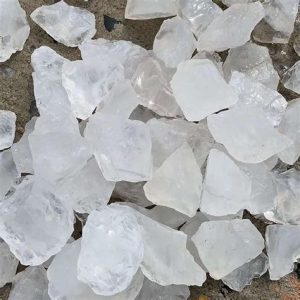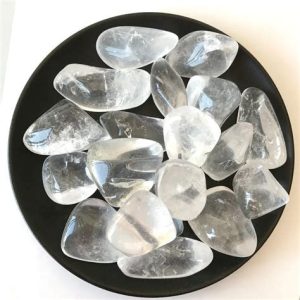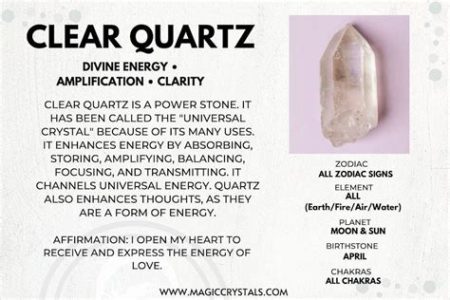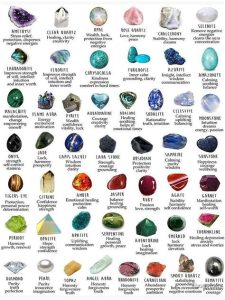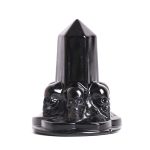Introduction
Magnetic crystals, also known as magnetic materials, are substances that exhibit magnetic properties when exposed to an external magnetic field. These materials are captivating researchers and engineers alike due to their unique abilities and the wide range of applications they offer. This article delves into the fascinating world of magnetic crystals, exploring their properties, applications, and potential future advancements.

Types of Magnetic Crystals
Magnetic crystals can be classified into several types based on their magnetic behavior:
- Ferromagnetic Crystals: Exhibit strong magnetic attraction, retaining their magnetism even after the external field is removed. Examples: magnetite, iron, nickel.
- Paramagnetic Crystals: Exhibit weak magnetic attraction and lose their magnetism when the external field is removed. Examples: aluminum, oxygen, platinum.
- Diamagnetic Crystals: Exhibit weak magnetic repulsion, opposing the external magnetic field. Examples: copper, gold, silver.
- Antiferromagnetic Crystals: Exhibit complex magnetic arrangements where spins of adjacent atoms oppose each other, resulting in a cancellation of magnetism. Examples: manganese oxide, chromium.
- Ferrimagnetic Crystals: Exhibit a combination of ferromagnetism and antiferromagnetism, resulting in a net magnetic moment. Examples: magnetite, lodestone.
Properties of Magnetic Crystals
Magnetic crystals possess various properties that make them valuable for scientific and technological applications:
- High Magnetic Permeability: Ability to enhance the magnetic field strength within the material.
- High Saturation Magnetization: Maximum magnetization that can be achieved under an applied magnetic field.
- Hysteresis: Lag in the magnetization of the material as the applied field changes direction.
- Anisotropy: Variation in magnetic properties depending on the crystallographic direction.
- Tunable Magnetic Properties: Ability to modify magnetic properties through chemical doping or external stimuli.
Applications of Magnetic Crystals
The unique properties of magnetic crystals have led to their widespread use in various fields:
- Electronics: Magnetic storage devices (hard disks, magnetic tapes), sensors, actuators, transformers.
- Energy: Wind turbines, electric motors, generators, transformers, energy storage systems.
- Medical: Magnetic resonance imaging (MRI), targeted drug delivery, hyperthermia therapy.
- Transportation: Levitation trains, hybrid vehicles, magnetic bearings.
- Communication: Magnetic antennas, microwave devices, wireless power transfer.
- Security: Magnetic locks, magnetic resonance scanners, anti-theft devices.
- Research: Fundamental studies of magnetism, quantum computing, spintronics.
Magnetic Crystals in 2025 and Beyond
The future of magnetic crystals is bright, with significant advancements expected in the coming years:
- Improved Performance: Enhanced magnetic properties through advanced synthesis techniques and novel materials.
- Miniaturization: Development of smaller and more efficient magnetic devices for electronics and energy applications.
- Multifunctional Materials: Integration of magnetic properties with other functionalities, such as optical, thermal, or electrical.
- Bio-Inspired Crystals: Design of magnetic crystals inspired by natural materials for applications in biotechnology and medicine.
Comparisons and Contrasts
Different types of magnetic crystals exhibit distinct properties and advantages:
| Crystal Type | Magnetic Strength | Applications |
|---|---|---|
| Ferromagnetic | Strong | Magnets, solenoids |
| Paramagnetic | Weak | Sensors, contrast agents |
| Diamagnetic | Repulsive | Levitation, shielding |
| Antiferromagnetic | Complex | Spintronics, quantum computing |
| Ferrimagnetic | Intermediate | Transformer cores, permanent magnets |
FAQs
-
What is the difference between a magnetic and a non-magnetic crystal?
– Magnetic crystals exhibit magnetic properties, while non-magnetic crystals do not. -
How can magnetic crystals be used to store data?
– Ferromagnetic crystals can be magnetized in specific patterns, storing binary information. -
What is the role of magnetic crystals in medical imaging?
– Magnetic crystals are used in MRI scans to generate contrast and enhance image quality. -
How are magnetic crystals being used in energy applications?
– Magnetic crystals are used in wind turbines, electric motors, and transformers to improve efficiency and performance. -
What is the potential of magnetic crystals in future technologies?
– Magnetic crystals hold promise for advancements in computing, energy storage, and biotechnology. -
How can the properties of magnetic crystals be tailored?
– Magnetic properties can be modified through chemical doping, external stimuli, or novel synthesis techniques. -
What are the challenges in developing magnetic crystals for practical applications?
– Challenges include achieving high performance, controlling crystal growth, and integrating multiple functionalities. -
What is the future outlook for magnetic crystals?
– The future outlook is optimistic, with continued research and development leading to innovative applications.
Market Insights
The global magnetic crystals market is projected to grow significantly by 2025, driven by rising demand from electronics, energy, and medical sectors. Key market trends include:
- Growing Adoption of Magnetic Sensors: Increasing use of magnetic sensors in smartphones, wearables, and industrial automation.
- Expansion of Magnetic Energy Storage: Development of new magnetic energy storage systems for renewable energy applications.
- Advancements in Biomedical Applications: Development of magnetic nanoparticles for targeted drug delivery and tissue regeneration.
Future Trends and Improvements
Future trends in magnetic crystals research and development include:
- Customized Magnetic Properties: Tailoring magnetic properties for specific applications through advanced synthesis and characterization techniques.
- Integration with Other Technologies: Combining magnetic crystals with other materials to create multifunctional devices with enhanced capabilities.
- Exploration of New Materials: Discovery and investigation of novel magnetic crystals with unique properties and potential applications.
- Sustainability and Environmental Friendliness: Developing environmentally friendly and sustainable methods for producing and using magnetic crystals.
Conclusion
Magnetic crystals, with their remarkable properties and diverse applications, continue to attract attention and drive innovation. From powering electronics to revolutionizing medical imaging, magnetic crystals are shaping the future of technology. As research and development advance, we can expect even more groundbreaking applications and transformative possibilities from these fascinating materials.







